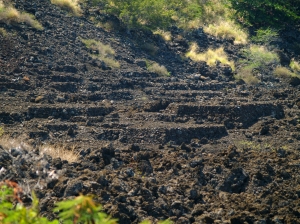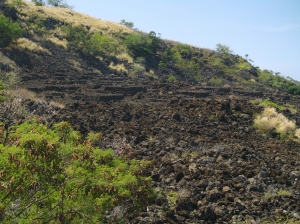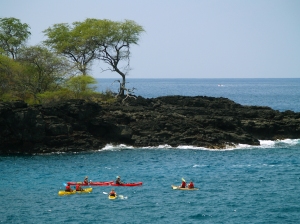Melancholy, lonely, desolate; this bench cut into the fresh scar of an a’a flow marks the place where the Hawai’ian gods died at the battle of Kuamo’o. Contact with Europeans, especially the whaling and trade fleets, had introduced the Christian religion to Hawai'ians.
Since the Europeans possessed many things; iron, tools, firearms, and much practical and scientific knowledge which the Hawai'ians had never even dreamed of, the ruling class of Hawai'ians considered the European god to be much stronger than their own gods, and began converting to Christianity in the early 19th Century. In 1819, the year before the Christian missionaries arrived in Hawai’i, forces loyal to Kamehameha II (Liholiho), his mother Kepiolani and the dowager Queen Ka’ahumanu began a social movement to overturn the kapu system and the pagan Hawai’ian religion in favor of Christianity.
Many Hawai'ians were unhappy with the abandonment of the old customs, laws and the old gods. Among the priestly class of Kahuna, Kuaiwa and Holoialena were particularly outraged and traveled the countryside haranguing and inciting the Hawaiians to rebellion against the young King Kamehameha II. The son of Kamehameha I's younger brother, the Ali'i Kekuaokalani (Liholiho's cousin), led the rebellious warriors and fought a desperate battle here at Kuamo'o to preserve their ancient way of life and to honor their ancient gods. Although both sides used Western weaponry, Kekuaokalani and his forces lost decisively. Both Kekuaokalani and his wife Manono, who fought beside him, died here. Their graves, along with the graves of warriors numbering in the several hundreds, lie under the numerous, large stone altars erected by the victors over the very spots the warriors fell, here at Lekeleke Graveyard.
Those rebels willing to accept the new god and pledge allegiance to the young King Liholiho were pardoned, but resistance among many lingered. Kamehameha II despatched Hoapili to Waimea to battle the last rebels and his victory over them effectively ended all opposition to the overthrow of the gods. Little did the Hawai'ian people realize that this was not just another of the interminable internecine wars between rival Ali'i, but in fact marked the beginning of the end of Hawai'ian culture as they had known it.
A walk along the dirt road that bisects Kuamo'o Battlefield is ineffably sad and a little creepy. However, the road soon climbs into dryland forest along the lava ocean cliffs and provides some memorable hiking and mountain biking. The shoreline at Kuamo'o is a great place for whale watching, a picnic in the rough, watching waves batter the headland and sunset views. The little bay here is a great fishing spot and kayak destination...numerous small caves and arches, inconspicuous from shore, call out for the kayaker to explore. Kuamo’o Battlefield is located at the very end of Ali’i Drive at an area know by locals, somewhat appropriately, as "The End of the World". There are no facilities.
A video about Kuamo'o Battlefield is available here.
For more information on traveling to Hawaii in general and touring the Big Island in particular, please also visit www.tourguidehawaii.com and www.lovingthebigisland.wordpress.com.
All media copyright 2009 by Donald B. MacGowan, all rights reserved.





No comments:
Post a Comment